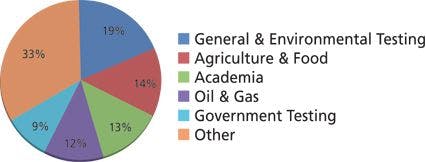Market Profile: GC–MS
Gas chromatography–mass spectrometry (GC–MS) combines a gas chromatographic front-end separation with a mass spectrometer.
Gas chromatography–mass spectrometry (GC–MS) combines a gas chromatographic front-end separation with a mass spectrometer. For the most part, the gas chromatographs and mass spectrometers used are modular in design and can be separated relatively easily. GC–MS is the most widespread tandem technique in the analytical instrumentation industry and is employed in many different industries, particularly for environmental, chemical, and toxicological applications.
The mass analyzers used in GC–MS include quadrupole, ion trap, and time of flight (TOF). Quadrupole mass analyzers consist of four parallel rods. By simultaneously changing both the DC and RF amplitudes applied to the rods, ions of various sizes (mass-to-charge ratios [m/z]) are able to pass through the quadrupole to the detector.

GCâMS industrial distribution.
Ion-trap mass analyzers use an electric field that is generated by a sandwich geometry in which a space is bounded in three dimensions by ring and cap electrodes on each end. Ions of selected range of m/z values are trapped in the space bound by the electrodes, and the electric field is varied to eject ions of increasing m/z values for detection. Ion-trap analyzers can perform multiple MS-MS dissociations as well.
In TOF mass analyzers, which operate in a pulsed mode rather than a continuous mode, all the ions are accelerated to the same kinetic energy and are pulsed into the field-region of the flight tube. Ions with different m/z values arrive at the detector at different times. Lighter atoms with higher velocities arrive before the heavier atoms.
General and environmental testing laboratories account for nearly one fifth of the overall GC–MS usage. Agriculture and food and academic industries follow with 14% and 13%, respectively. The remaining two industries in the top-five list include oil and gas, and government testing, with a combined industrial market share of 21%.
The foregoing data were extracted and adapted from SDi's recently published Global Assessment Report, 12th Edition. For more information, visit www.strategic-directions.com

Regulatory Deadlines and Supply Chain Challenges Take Center Stage in Nitrosamine Discussion
April 10th 2025During an LCGC International peer exchange, Aloka Srinivasan, Mayank Bhanti, and Amber Burch discussed the regulatory deadlines and supply chain challenges that come with nitrosamine analysis.
Top Execs from Agilent, Waters, and Bruker Take the Stage at J.P. Morgan Healthcare Conference
January 16th 2025The 43rd Annual Healthcare J.P. Morgan Healthcare Conference kicked off in San Francisco earlier this week. Here’s what top executives from Agilent, Bruker, and Waters, discussed during the event.







